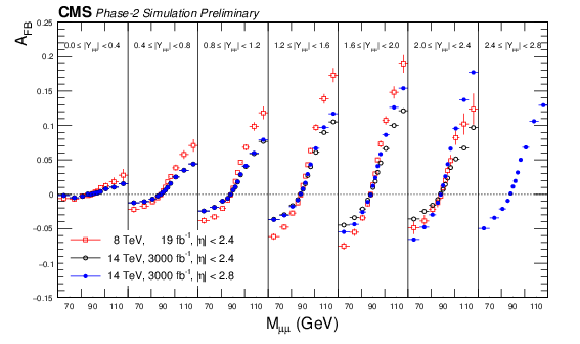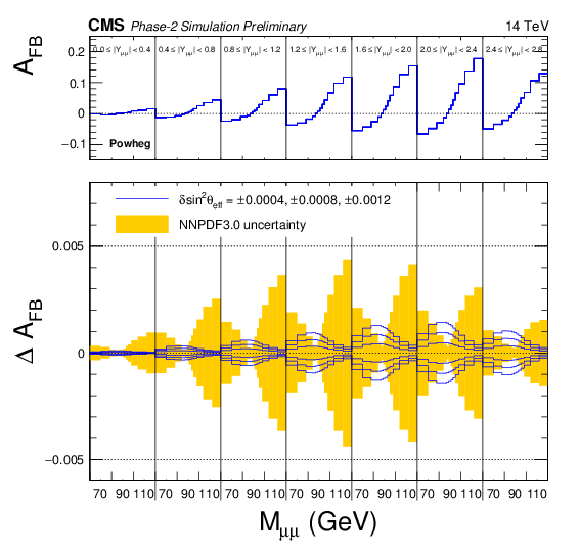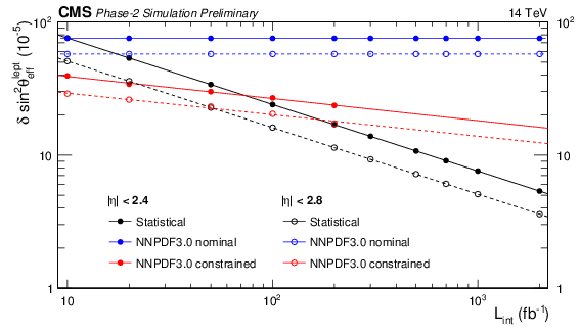

Compact Muon Solenoid
LHC, CERN
| CMS-PAS-FTR-17-001 | ||
| A proposal for the measurement of the weak mixing angle at the HL-LHC | ||
| CMS Collaboration | ||
| December 2017 | ||
| Abstract: A proposal is presented for measuring the weak mixing angle using the forward-backward asymmetry of Drell-Yan dimuon events in pp collisions at $\sqrt{s} = $ 14 TeV with the CMS detector at the high luminosity LHC (HL-LHC). In addition to the increased luminosity, the upgraded part of the muon system extends the pseudorapidity coverage of the CMS experiment to $|\eta| < $ 2.8 for muons. Since the measurement has higher sensitivity in this pseudorapidity region, both the statistical and systematic uncertainties will be significantly reduced. To estimate the increased potential for this measurement we use a Monte Carlo data sample of pp events corresponding to a luminosity of 3000 fb$^{-1}$ and compare to the recent CMS measurements at $\sqrt{s} = $ 8 TeV. | ||
| Links: CDS record (PDF) ; inSPIRE record ; CADI line (restricted) ; | ||
| Figures | |

png pdf |
Figure 1:
Forward-backward asymmetry distribution, $ {A_\text {FB}} (M_{\mu \mu},Y_{\mu \mu})$, in dimuon events at $\sqrt {s} = $ 8 TeV and 14 TeV. The distributions are made with POWHEG event generator using NNPDF3.0 PDFs and interfaced with PYTHIA 8 for parton-showering, QED final-state radiation (FSR) and hadronization. Following acceptance selections are applied to the generated muons after FSR: $|\eta | < $ 2.4 (or $|\eta | < $ 2.8), $ {p_{\mathrm {T}}} ^\mathrm {lead} > $ 25 GeV, $ {p_{\mathrm {T}}} ^\mathrm {trail} > $ 15 GeV. The error bars represent the statistical uncertainties for the integrated luminosities corresponding to 19 fb$^{-1}$ at $\sqrt {s} = $ 8 TeV and 3000 fb$^{-1}$ at $\sqrt {s} = $ 14 TeV. |

png pdf |
Figure 2:
Forward-backward asymmetry distribution, $ {A_\text {FB}} (M_{\mu \mu},Y_{\mu \mu})$, in dimuon events at $\sqrt {s} = $ 14 TeV. The distributions are made with POWHEG event generator using NNPDF3.0 PDFs and interfaced with PYTHIA 8 for parton-showering, QED final-state radiation (FSR) and hadronization. Following acceptance selections are applied to the generated muons after FSR: $|\eta | < $ 2.8, $ {p_{\mathrm {T}}} ^\mathrm {lead} > $ 25 GeV, $ {p_{\mathrm {T}}} ^\mathrm {trail} > $ 15 GeV. The solid lines in the bottom panel correspond to six variations of $ {\sin^2\theta ^{\text {lept}}_{\text {eff}}} $ around the central value: $ \pm $0.0004, $ \pm $0.0008, and $ \pm $0.0012. The shaded band shows the standard deviation over the 100 NNPDF3.0 replicas. |

png pdf |
Figure 3:
Projected statistical, nominal PDF and constrained PDF uncertainties in $ {\sin^2\theta ^{\text {lept}}_{\text {eff}}} $ extracted by fitting $ {A_\text {FB}} (m_{\mu \mu},y_{\mu \mu})$ distributions at $\sqrt {s} = $ 14 TeV with different values of integrated luminosities and for $|\eta | < $ 2.4 and $|\eta | < $ 2.8 acceptance selections for the muons. The nominal NNPDF3.0 uncertainty is calculated as a standard deviation of the extracted $ {\sin^2\theta ^{\text {lept}}_{\text {eff}}} $ over the 100 NNPDF3.0 replicas. To calculate the constrained NNPDF3.0 uncertainty, each replica is weighted by $ \exp(-\chi ^2_{\mathrm {min}}/2)$, where $\chi ^2_{\mathrm {min}}$ is the best-fit $\chi ^2$ obtained with this replica. |
| Tables | |

png pdf |
Table 1:
Statistical, nominal NNPDF3.0, and constrained NNPDF3.0 uncertainties of extracted $ {\sin^2\theta ^{\text {lept}}_{\text {eff}}} $ at 14 TeV for muon acceptance of $|\eta | < $ 2.4 and $|\eta | < $ 2.8 and for the different values of integrated luminosity. For comparison, results of the 8 TeV estimate of this analysis are compared to the results obtained from 8 TeV measurement [1]. |
| Summary |
| We presented prospects for precision ${\sin^2\theta^{\text{lept}}_{\text{eff}}} $ measurement with the upgraded CMS detector at the high-luminosity LHC. We find that extending the lepton acceptance from $|\eta| < $ 2.4 to 2.8 decreases the statistical uncertainties by about 30% and PDF uncertainties by about 20%. We also find that starting from about 1000 fb$^{-1}$, a single measurement would already have a negligible statistical uncertainty and the PDF uncertainty could be constrained to improve the precision of ${\sin^2\theta^{\text{lept}}_{\text{eff}}} $ measurement. |
| References | ||||
| 1 | CMS Collaboration | Measurement of the weak mixing angle with the forward-backward asymmetry of Drell-Yan events at 8 TeV | CMS-PAS-SMP-16-007 | CMS-PAS-SMP-16-007 |
| 2 | J. C. Collins and D. E. Soper | Angular Distribution of Dileptons in High-Energy Hadron Collisions | PRD 16 (1977) 2219 | |
| 3 | SLD Electroweak Group, DELPHI, ALEPH, SLD, SLD Heavy Flavour Group, OPAL, LEP Electroweak Working Group, L3 Collaboration | Precision electroweak measurements on the $ Z $ resonance | PR 427 (2006) 257 | hep-ex/0509008 |
| 4 | CMS Collaboration | Measurement of the weak mixing angle with the Drell-Yan process in proton-proton collisions at the LHC | PRD 84 (2011) 112002 | CMS-EWK-11-003 1110.2682 |
| 5 | ATLAS Collaboration | Measurement of the forward-backward asymmetry of electron and muon pair-production in $ pp $ collisions at $ \sqrt{s} = $ 7 TeV with the ATLAS detector | JHEP 09 (2015) 049 | 1503.03709 |
| 6 | LHCb Collaboration | Measurement of the forward-backward asymmetry in $ Z/\gamma^{\ast} \rightarrow \mu^{+}\mu^{-} $ decays and determination of the effective weak mixing angle | JHEP 11 (2015) 190 | 1509.07645 |
| 7 | CDF Collaboration | Indirect measurement of $ \sin^2 \theta_W $ (or $ M_W $) using $ \mu^+\mu^- $ pairs from $ \gamma^*/Z $ bosons produced in $ p\bar{p} $ collisions at a center-of-momentum energy of 1.96 TeV | PRD 89 (2014) 072005 | 1402.2239 |
| 8 | CDF Collaboration | Measurement of $ \sin^2\theta^{\rm lept}_{\rm eff} $ using $ e^+e^- $ pairs from $ \gamma^*/Z $ bosons produced in $ p\bar{p} $ collisions at a center-of-momentum energy of 1.96 TeV | PRD 93 (2016) 112016 | 1605.02719 |
| 9 | D0 Collaboration | Measurement of the effective weak mixing angle in $ p\bar{p}\rightarrow Z/\gamma^{*}\rightarrow e^{+}e^{-} $ events | PRL 115 (2015) 041801 | 1408.5016 |
| 10 | S. Alioli, P. Nason, C. Oleari, and E. Re | NLO vector-boson production matched with shower in POWHEG | JHEP 07 (2008) 060 | 0805.4802 |
| 11 | P. Nason | A new method for combining NLO QCD with shower Monte Carlo algorithms | JHEP 11 (2004) 040 | hep-ph/0409146 |
| 12 | S. Frixione, P. Nason, and C. Oleari | Matching NLO QCD computations with parton shower simulations: the POWHEG method | JHEP 11 (2007) 070 | 0709.2092 |
| 13 | S. Alioli, P. Nason, C. Oleari, and E. Re | A general framework for implementing NLO calculations in shower Monte Carlo programs: the POWHEG BOX | JHEP 06 (2010) 043 | 1002.2581 |
| 14 | NNPDF Collaboration | Parton distributions for the LHC Run II | JHEP 04 (2015) 040 | 1410.8849 |
| 15 | T. Sjostrand, S. Mrenna, and P. Z. Skands | A Brief Introduction to PYTHIA 8.1 | CPC 178 (2008) 852 | 0710.3820 |
| 16 | CMS Collaboration | Event generator tunes obtained from underlying event and multiparton scattering measurements | EPJC 76 (2016) 155 | CMS-GEN-14-001 1512.00815 |
| 17 | W. T. Giele and S. Keller | Implications of hadron collider observables on parton distribution function uncertainties | PRD 58 (1998) 094023 | hep-ph/9803393 |
| 18 | N. Sato, J. F. Owens, and H. Prosper | Bayesian Reweighting for Global Fits | PRD 89 (2014) 114020 | 1310.1089 |
| 19 | A. Bodek, J. Han, A. Khukhunaishvili, and W. Sakumoto | Using Drell-Yan forward-backward asymmetry to reduce PDF uncertainties in the measurement of electroweak parameters | EPJC 76 (2016) 115 | 1507.02470 |

|
Compact Muon Solenoid LHC, CERN |

|

|

|

|

|

|